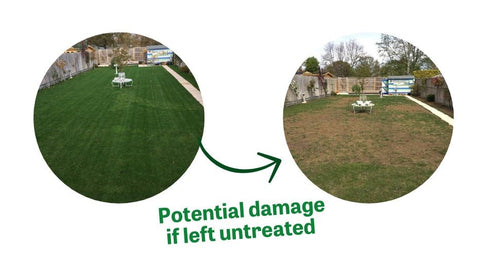We are often asked how to get rid of grass-eating bugs as lawn pests have the potential to devastate your once vibrant and healthy lawn, transforming it into patches of discoloured and lifeless turf. Prompt treatment of lawn pests is crucial, as the severity of infestation directly correlates with the extent of damage inflicted upon the lawn. Ignoring these pests can lead to irreversible harm, jeopardising the beauty and health of your outdoor space.

Our lawn pest control for lawns can help to manage the number of pests in your lawn while improving the overall health of the grass sward. We can also relieve stress and help your lawn to recover from the damage caused by common lawn pests like Chafer Grubs and Leatherjackets.
How to identify pests in your lawn:
Leatherjackets –

You may notice the Leatherjacket grubs coming out of the grass or you may see damage along the borders of your lawn. At the start of the infestation, they eat the grass roots from the outside of the lawn inwards.
The Leatherjackets lifecycle starts when the female lays her eggs in the lawn around September, they hatch 2-3 weeks later. By February/March, the pests will have grown, and the damage will be much more extensive. Quite simply, the higher the number of Leatherjackets visible on the surface of the lawn, the larger the infestation. The most effective time to treat, is when the grubs are small, end of September through to early November.
(Did you know? The adult is known as the Crane Fly or Daddy Long Legs and at the larvae stage of the life cycle this creature is called a Leatherjacket).
Chafer Grubs –

When you have Chafer Grub damage your lawn may lose colour in a certain area, appearing pale green, as opposed to its normal colour; these can start off as patches. Additionally, external damage can be caused by birds, badgers, etc. who will pull the lawn up to eat the grubs. If you pull at your lawn and it lifts easily from the soil, you may see grubs near the surface. This most likely means that you have a Chafer Grub infestation and need our Pest Management Treatment.
Between mid-July and October is when Chafer Grubs are most active, although dependent on weather conditions, this period could be even longer. This is the optimal treatment period is when they are at their smallest, this is from the end of May through to July.
Lawn Pest Control
We are proud to offer a range of Pest Management Treatments which have all been designed to deter lawn pests and lawn bugs, reducing damage and helping your lawn recover.
Depending on the severity of the infestation and the lifecycle of the grubs, we offer several effective solutions:
NutraShield Pest Control
As the name suggests, this lawn pest control treatment shields the grass from the damage which can be caused by the pests we find in lawns in the UK. The product we use is effective at reducing the numbers of grubs in the lawn so limits damage and supports growth for the next season.
BioStimulant Treatment
Our BioStimulant Pest Management Treatment support the recovery of your grass after a pest attack. This treatment can also deter the pests from eating the plant, reducing further damage.
Your GreenThumb Lawn Operative will carefully evaluate your lawn’s condition and recommend the best treatment, or even a combination of treatments most suitable to your lawn’s needs.
To ensure the best outcome, we advise you to take action as soon as you spot crane flies (also known as daddy long-legs) on your lawn. This is the right time to reach out to your local GreenThumb branch. Treating the grubs at an early stage significantly enhances the speed and effectiveness of your lawn’s recovery process.
As well as our range of Lawn Service Pest Control Treatments, our routine NutraGreen treatments also play a role in speeding up the recovery process, so your lawn can get back to its lush, healthy self.
